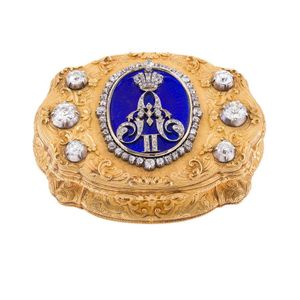Tsar Nicholas I porcelain dessert plate with imperial insignia
You must be a subscriber, and be logged in to view price and dealer details.
Subscribe Now to view actual auction price for this item
When you subscribe, you have the option of setting the currency in which to display prices to $Au, $US, $NZ or Stg.
- Oviform /ovoid - The outline loosely resembling the shape of an egg.
- Gilding - Gilding is a method of ornamentation whereby a thin sheet of gold metal is applied to items made of wood, leather, ceramics, glass and silver for decorative purposes.
For furniture including mirrors, the sheet of gold is usually applied over a coating of gesso. Gesso is a mixture of plaster of Paris and gypsum mixed with water and then applied to the carved wooden frames of mirrors and picture frames as a base for applying the gold leaf. After numerous coats of gesso have been applied, allowed to dry and then sanded a coat of "bole", a usually red coloured mixture of clay and glue is brushed on and allowed to dry, after which the gold leaf is applied. Over time parts of the gilding will rub off so the base colour can be seen. In water gilding, this was generally a blue colour, while in oil gilding, the under layer was often yellow. In Victorian times, gilders frequently used red as a pigment beneath the gold leaf.
Metal was often gilded by a process known as fire gilding. Gold mixed with mercury was applied and heated, causing the mercury to evaporate, the long-term effect of which was to kill or disable the craftsman or woman from mercury poisoning. The pursuit of beauty has claimed many victims, not the least of which were the artists who made those pieces so highly sought after today. - Gadrooning - A series of lobes usually as a border. In furniture gadrooning is found as carved decoration around the edges of table tops in the Chippendale and Jacobean style furniture. Gadrooning is also found as decoration on the rims of silver and ceramics.
This item has been included into following indexes:
Visually similar items

An antique English Coalport cabinet plate with hand decorated floral bouquets and gilt highlighting

An Art Nouveau 18ct yellow gold and diamond brooch by Lucien Joseph Rene Janvier, the brooch with a bust of a lady inset with rose cut diamonds and emeralds. Lucien Joseph Rene Janvier (b. 1878) was a Belgian sculptor, jeweller, medallist and pupil of Fren

An early 29th century Royal Worcester hand painted plate, the centre with peaches and grapes, the elaborate border with cobalt blue ground, painted roses and gilt enrichments. Date marks for 1912. Diameter 23 cm

An important diamond set enamel and gold Russian Imperial presentation box with monogram of Tsar Alexander II (1855-1881), mark of Carl Martin Weishaupt Und Sohne, hand crafted in gold, the ornately sculptured and engraved hinged box measuring 90 x 60 x 35
